The FMCG Automation Playbook: AI Workflows That Actually Work

From spreadsheets to smart workflows—see how FMCG brands are cutting through complexity with AI-powered automation that actually works.
Margins are tightening. Consumer habits are shifting faster than ever. And your warehouse management team just spent three hours reconciling stock using a spreadsheet from last Tuesday.
Sound familiar?
Welcome to the daily grind of small and medium-sized enterprises (SMEs) in the Fast-Moving Consumer Goods (FMCG) industry. While the world’s grand corporations are busy fine-tuning their AI-driven supply chains, many SMEs are still juggling siloed systems, gut-based decisions, and last-minute scrambles. But here’s the twist: the tech gap between you and global giants is closing quickly.
AI in FMCG automation is no longer just a dream reserved for major corporations. It’s a beacon of hope, an increasingly accessible tool for businesses of all sizes to streamline operations, forecast demand, and stop leaving money on the table. This article is your no-nonsense guide to what AI and agentic automation actually mean for the FMCG sector. More importantly, it's a roadmap for how your business can start using it to compete smarter, not just harder.
We’ll break down the benefits, use cases, challenges, and how to get started with artificial intelligence automation, without needing a data scientist on speed dial.
Let’s get into it.
What AI (and Agentic AI) Actually Means for FMCG
Let’s cut through the noise. When people hear “AI in FMCG automation”, it can conjure up images of robot arms in warehouses or complex algorithms known only to Silicon Valley types. But in reality, artificial intelligence, and more specifically, agentic AI, is far more practical and grounded than that.
At its core, AI automation means using smart technology to take on repetitive, time-consuming tasks that bog down your team. For instance, tasks like inventory management, order restocking, or restock predictions. It’s not magic. It’s logic, powered by data.
The technologies behind this include:
- Machine learning models (ML), which help spot patterns and predict demand from your sales data;
- Natural language processing (NLP) is used to automate customer interactions or process unstructured information;
- Robotic process automation (RPA), which handles repetitive digital tasks like data entry;
- Computer vision is sometimes used to track stock visually or monitor shelf conditions.
Now, agentic AI takes it a step further. Think of it as AI that doesn’t just analyze and suggest, it takes action. Rather than waiting for you to press a button, agentic automation works within set rules and goals to make decisions on your behalf, in real time. For example:
- If stock drops below a certain threshold, it automatically reorders to even out inventory levels.
- If a shipment is delayed, it triggers an alert and adjusts your delivery timeline.
- If demand is spiking for a specific SKU, it flags the market trend and starts inventory optimization and reallocation.
Agentic AI agents act as background processes that make decisions using real-time data within defined rules, reducing manual oversight and allowing teams to focus on strategic work.
What’s changed is cost. These capabilities are now available at a fraction of the investment previously required. Smart, accessible AI-driven solutions are now bringing agentic automation to the FMCG industry, enabling even small teams to tap into it.
Why You Need AI in the FMCG Industry Right Now?
Running a successful FMCG business today means juggling a dozen moving parts like inventory levels, customer demand, supply chain hiccups, marketing campaigns, and more. It’s enough to make anyone’s head spin.
That’s exactly where AI in FMCG automation steps in, with the benefits of automation that transform chaos into clarity and guesswork into informed action.
Here’s why investing in AI isn’t just a tech trend, but it’s becoming a business imperative:
- Accurate demand forecasting to stay ahead: AI crunches mountains of data, from past sales to consumer trends, so you’re never caught off guard by sudden shifts in customer demand (Basson, L. M et al., 2019).
- Optimized inventory management to reduce waste and free up cash: Predictive analytics translates into smarter stocking, less spoilage, fewer lost sales, and more money staying in your business (Suwignjo et al., 2023).
- Faster order processing that improves customer experience: Automation speeds up processing, packing, and shipping, helping you deliver on time, every time (Alicke et al., 2017).
- Supply chain optimization to minimize delays and costs: AI spots bottlenecks before they snowball, helping you avoid costly disruptions and keep products flowing smoothly (KPMG, 2024).
- Smarter marketing and personalized promotions to boost sell-through rates: Targeted campaigns and personalized offers get your products flying off the shelves, growing loyal customers along the way (McKinsey & Company, 2025).
In short, AI in FMCG automation turns your business from reactive to proactive, giving you the edge in a fiercely competitive market.
And don’t worry, these aren’t just for the big players. No-code AI-powered solutions enable SMEs to harness the benefits of automation to work smarter, not harder.
From Big Brands to Small Shops: AI Isn’t Just for Giants Anymore
When you think of AI in the FMCG companies, names like PepsiCo, Kraft Heinz, and L’Oréal probably come to mind, and for good reason. These giants have invested heavily in AI-driven supply chains, demand forecasting, and marketing automation. For instance:
- PepsiCo uses AI-driven analytics to drive product innovation, optimizing product mixes and reducing waste across its global supply chain. In one internal deployment, prediction accuracy rose to nearly 98 % (TAZI, 2023). Not bad for a machine.
- Kraft Heinz leverages machine learning to improve demand forecasting, trim excess inventory, and cut costs. In 2023 alone, AI-powered automation helped them save around $700 million across supply chain operations, with another $173 million saved in Q1 2024 (Proactive Investors, 2024).
- L’Oréal uses AI to deliver personalized marketing campaigns that boost customer engagement and sales. In a recent Brazilian campaign, AI‑driven analytics delivered a 155 % increase in ROI, clear proof that intelligent automation pays (TI Inside Online, 2024).
But here’s the thing: these breakthroughs aren’t reserved for billion-dollar budgets anymore. Thanks to AI-driven tools like Capably, SME FMCG companies can now tap into agentic AI and automation workflows that were once out of reach, gaining a competitive edge.
The playing field is levelling. The advantage goes to businesses that adopt AI intelligently, regardless of size. If the big players are sprinting ahead with AI, now’s your chance to keep pace, or better yet, take the lead.
Who Benefits from FMCG Automation?
Spoiler, it’s not just the tech teams.
Let’s clear up a common misconception: AI-based automation solutions aren’t just for IT departments, data scientists, or Silicon Valley types. The real value? It shows up across your entire organization, especially in places where time, money, and decisions really count.
Here’s a quick tour of the teams that stand to gain big:
🛒 Sales & Commercial Teams: Imagine having a machine learning model quietly crunching sales data to spot trends before your competitors do. AI automations can improve sell-through rates, personalize promos, and enable dynamic pricing strategies, all without wrestling with chaotic spreadsheets.
📦 Supply Chain Management & Operations: Supply chain teams benefit from predictive analytics, demand forecasting, and real-time visibility that turn gut feelings into data-backed decisions and stellar operational efficiency.
📈 Finance Teams: No more playing inventory roulette. With AI forecasting, actionable insights, and optimized planning, finance gets a clearer view of working capital and risk. Expect clearer views of working capital and risk, enabling leaner stock and sharper cash flow forecasts.
🎯 Marketing Teams: From NLP-powered messaging tweaks to smart audience segmentation, professionals can run personalized marketing campaigns at scale, boosting engagement and ROI.
🤝 Customer Service Teams: AI chatbots and automated ticket routing reduce wait times, improve resolution speed, and customer satisfaction. NLP tools help flag urgent consumer sentiment, so you can respond with a human touch where it matters, and automate the rest with confidence.
🧠 HR & People Teams: From AI-powered screening that reduces bias in hiring to workflow automations that handle repetitive admin (think onboarding, payroll queries, time-off approvals), HR teams get to focus on people, not paperwork, while minimizing operational costs.
🧑🏭 Founders, Owners & Senior Decision-Makers: Whether you’re managing a small chain of stores or an up-and-coming DTC brand, agentic automation puts time back on your calendar. You get more valuable insights, faster decisions, and smarter workflows without needing to hire a 12-person data team.
The bottom line?
AI in FMCG isn’t just about automation. It’s about empowerment. It helps teams shift from reactive firefighting to proactive growth and creativity.
AI in Action: Practical Workflows That Solve Real FMCG Problems
You know who benefits from AI in FMCG. But what does automation actually do on the ground?
If the idea of automation still feels abstract, you’re not alone. Many FMCG leaders know AI is the future. They just don’t know where to start or what to automate first.
This is where Capably makes things refreshingly straightforward. With our library of pre-built, no-code automation workflows, you can start automating business-critical tasks in minutes.
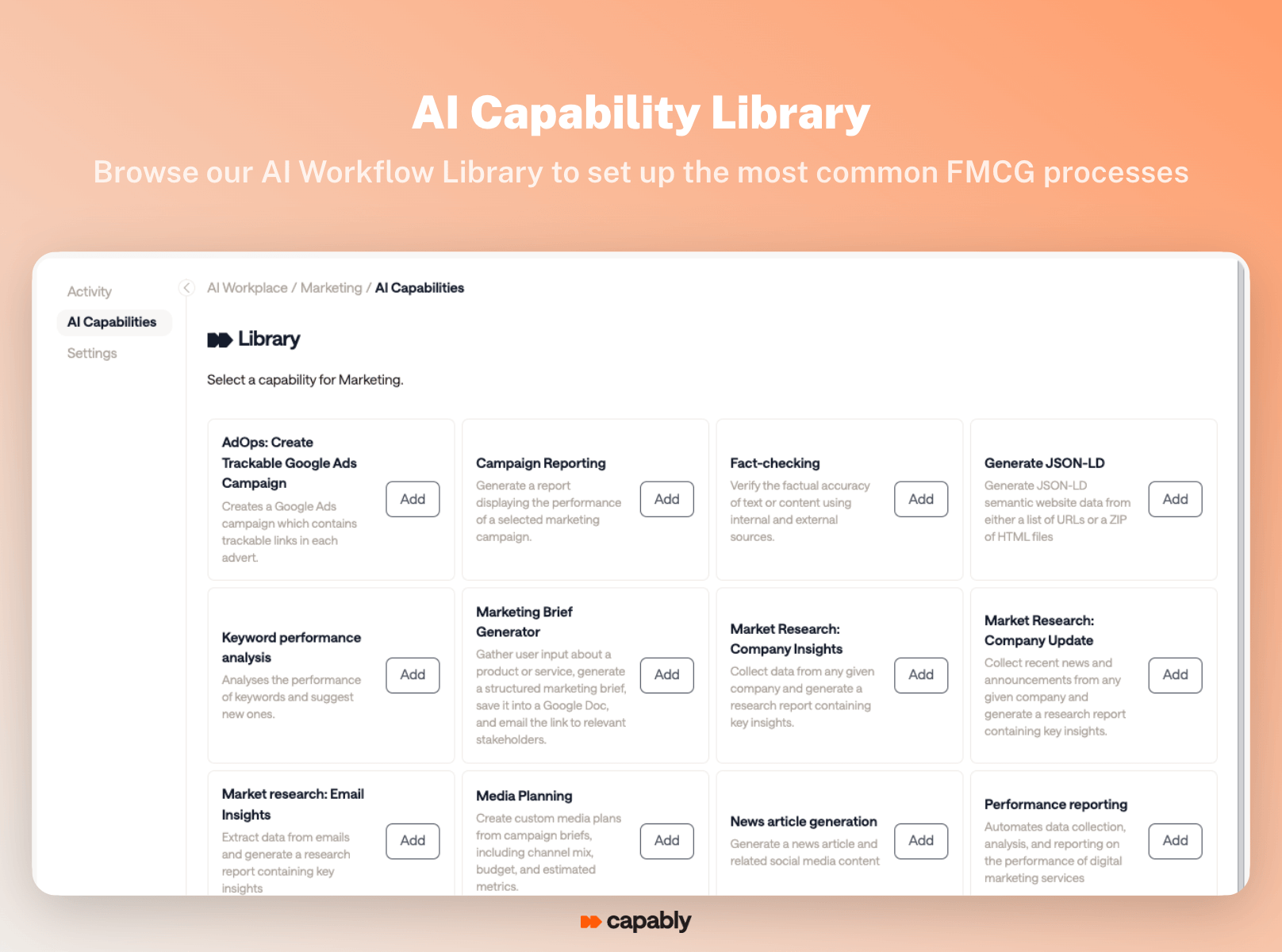
Or if your needs are more specific, our Describe–Criticize–Automate system lets you create custom agentic workflows in plain language. Again, no coding required.
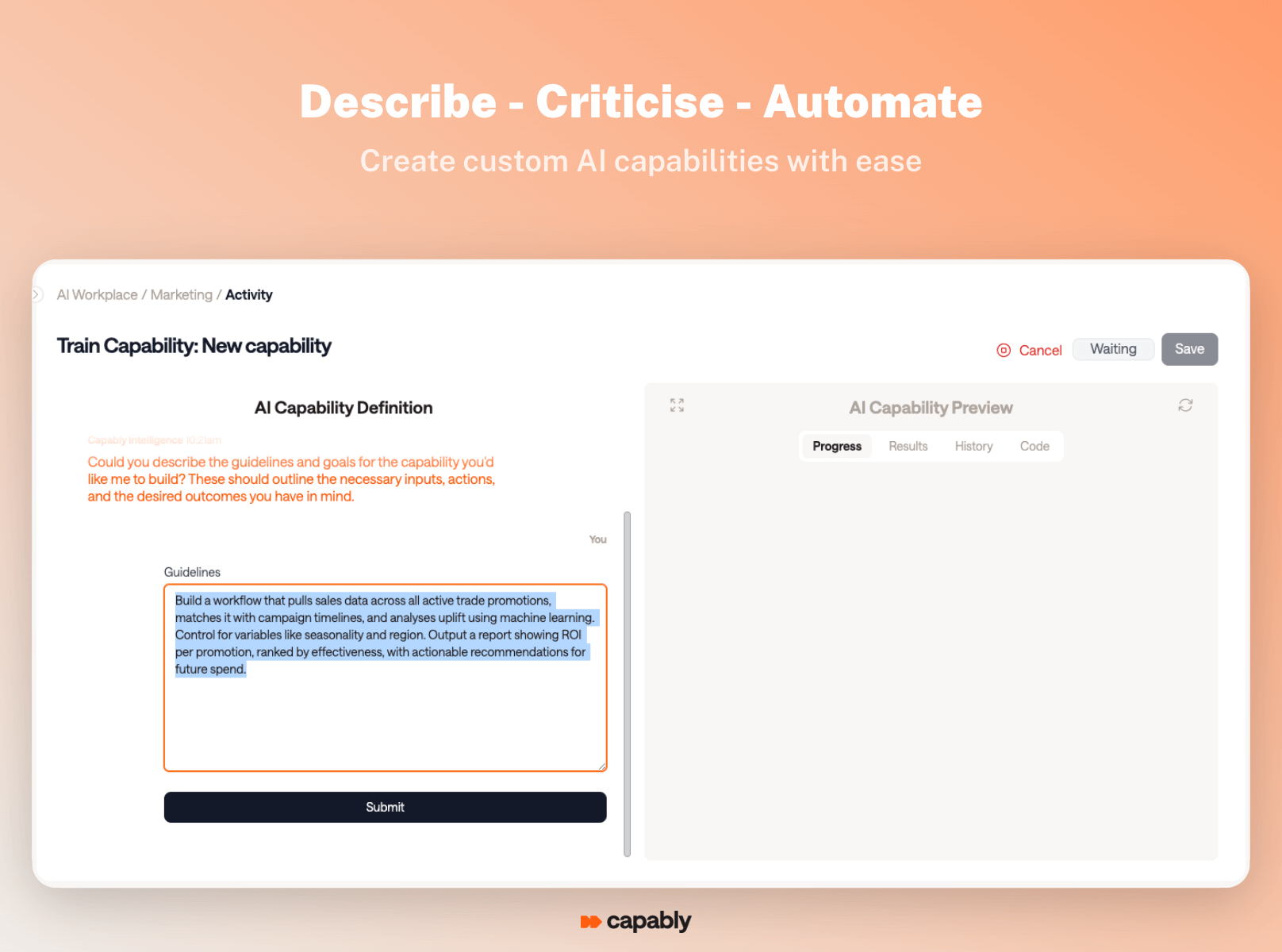
Ready to see automation in action? Here’s a look at some of the highest-impact workflow opportunities for FMCG brands, organized by the real-world problems they solve.
Supply Chain Efficiency: Better Forecasts, Smarter Stocking
For FMCG businesses, misjudging demand isn’t just inconvenient, it’s expensive. In one recent study across France, Spain and the UK, roughly 4 % of FMCG products were out‑of‑stock for an average of four days in 2022, costing the industry billions in lost revenue and weakening loyalty (NielsenIQ, 2022).
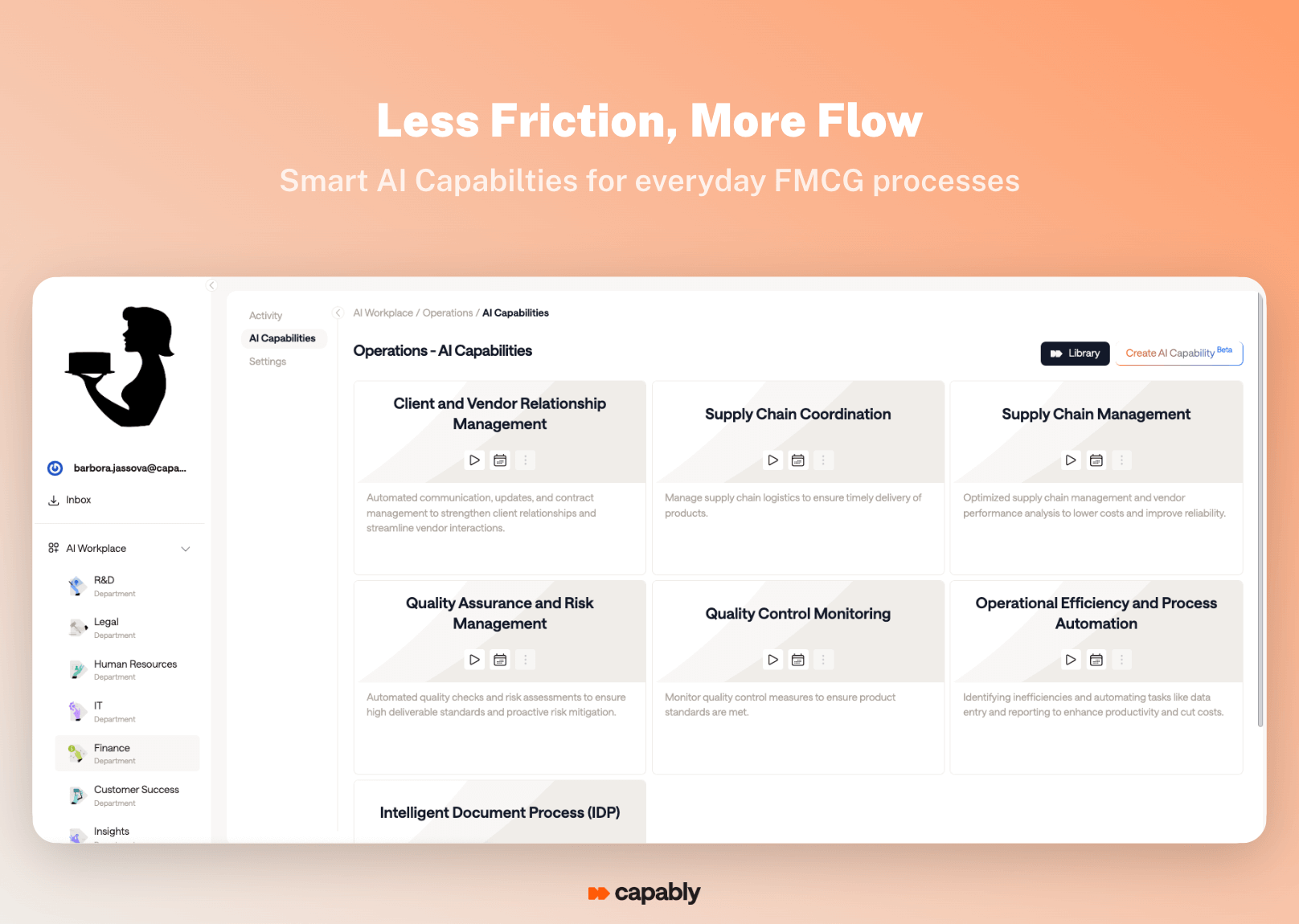
🧠 Market Demand Forecasting Automation
Using a machine‑learning algorithm, this workflow can help you generate more accurate, adaptive demand forecasts that account for seasonal patterns, real‑time data, promotions, and even external signals such as weather and regional events. Academic research shows that ML‑based models significantly outperform traditional methods in forecasting accuracy (Mohammed & Mandal, 2024).
📦 Smart Inventory Replenishment
No one likes firefighting stock issues. This workflow can automatically trigger restock actions across sales channels when thresholds are met. It keeps the right products moving at the right time without burdening your warehouse management system. Plus, with complete inventory control and high optimization, you also reduce unnecessary energy consumption. A recent study in cold‐chain logistics noted energy savings of about 20 % through real-time inventory and storage monitoring (Wang & Du, 2025).
And suppose you’re looking to go deeper. In that case, automation can also support anomaly detection in logistics, spot distribution delays before they escalate, reconcile ERP data to keep systems aligned, and update inventory records across platforms. This way, everyone is working from the same numbers.
Sales & Marketing: Smarter Spending, Sharper Messaging
For an FMCG company, small shifts in consumer attention or channel performance can make or break a quarter. Yet many teams still rely on lagging indicators and disconnected tools to guide big budget decisions. Agentic AI automation can give sales and marketing teams the clarity and speed they need to stay ahead.
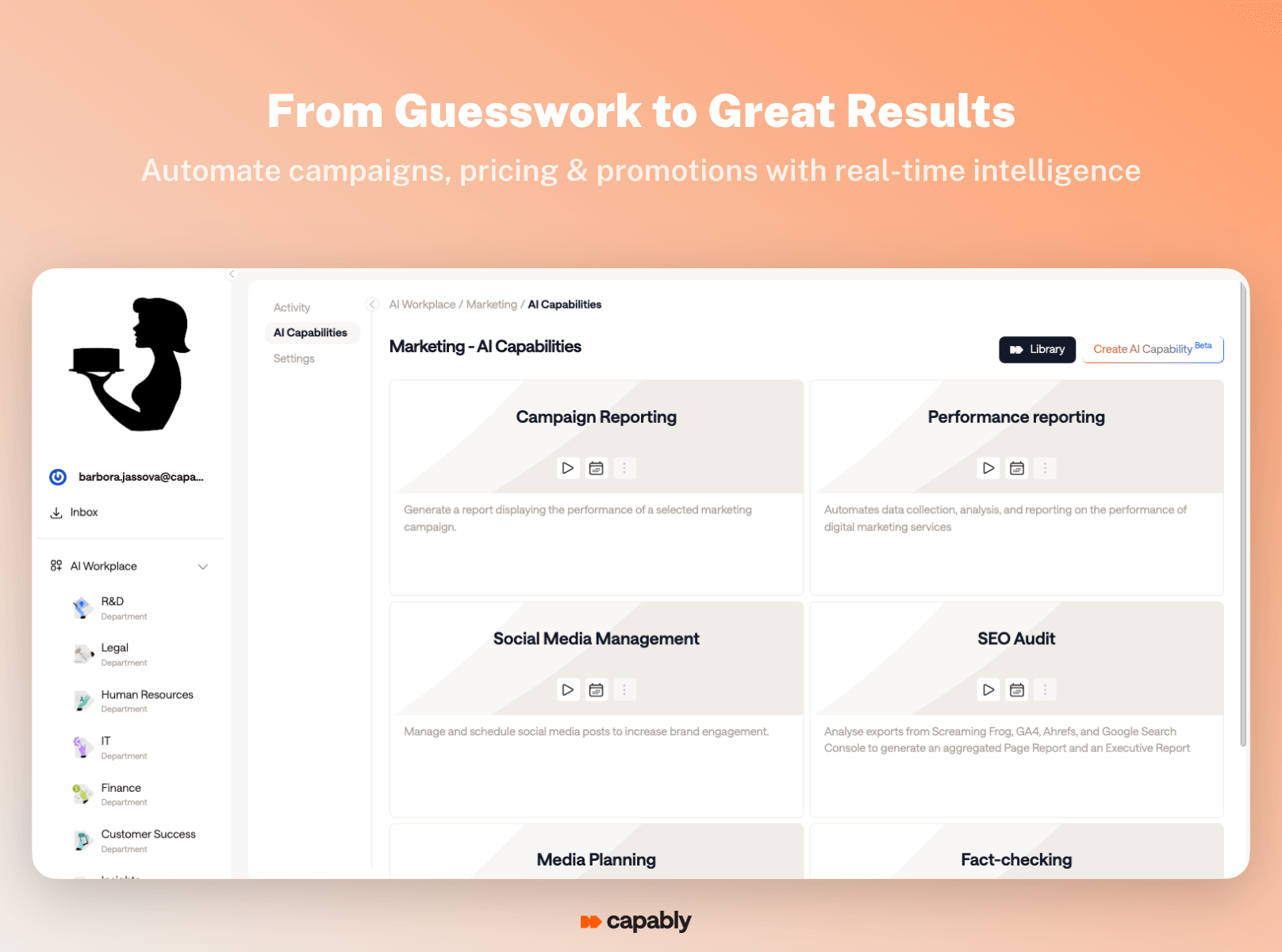
🔍 Consumer Behavior Trend Analysis
This workflow can help you spot emerging patterns in customer preferences before they hit your bottom line. Insights like these can guide product development decisions, ensuring your innovation pipeline stays aligned with shifting demand. By pulling from sales data, social media activity, search behavior, and even social sentiment, this workflow enables deeper data analysis, giving you a sharper read on what consumers are leaning into. So you can act, not react.
📊 Trade Promotion Effectiveness
Promotions can drive volume or drain margin. This workflow can help you assess which trade promotions are actually performing across regions and retailers. It uses machine learning to evaluate timing, pricing, and uplift, giving you evidence-based consumer insights to optimize future marketing strategies and spend.
On top of these, agentic automation can also support initiatives like digital shelf optimization (so your products are always positioned to win), retailer and distributor insights, and the creation of tailored sales enablement materials. All of that can amplify reach while keeping teams focused on strategy, not admin.
Customer Experience: Better Support, Happier Customers
In FMCG, customer satisfaction is often handled behind the scenes, but it has a front-row impact on brand loyalty and repeat sales. Whether you’re B2C or working through distributors, timely, accurate service matters. Automation can step in to handle the repetitive, high-volume tasks so your team can focus on the conversations that count.
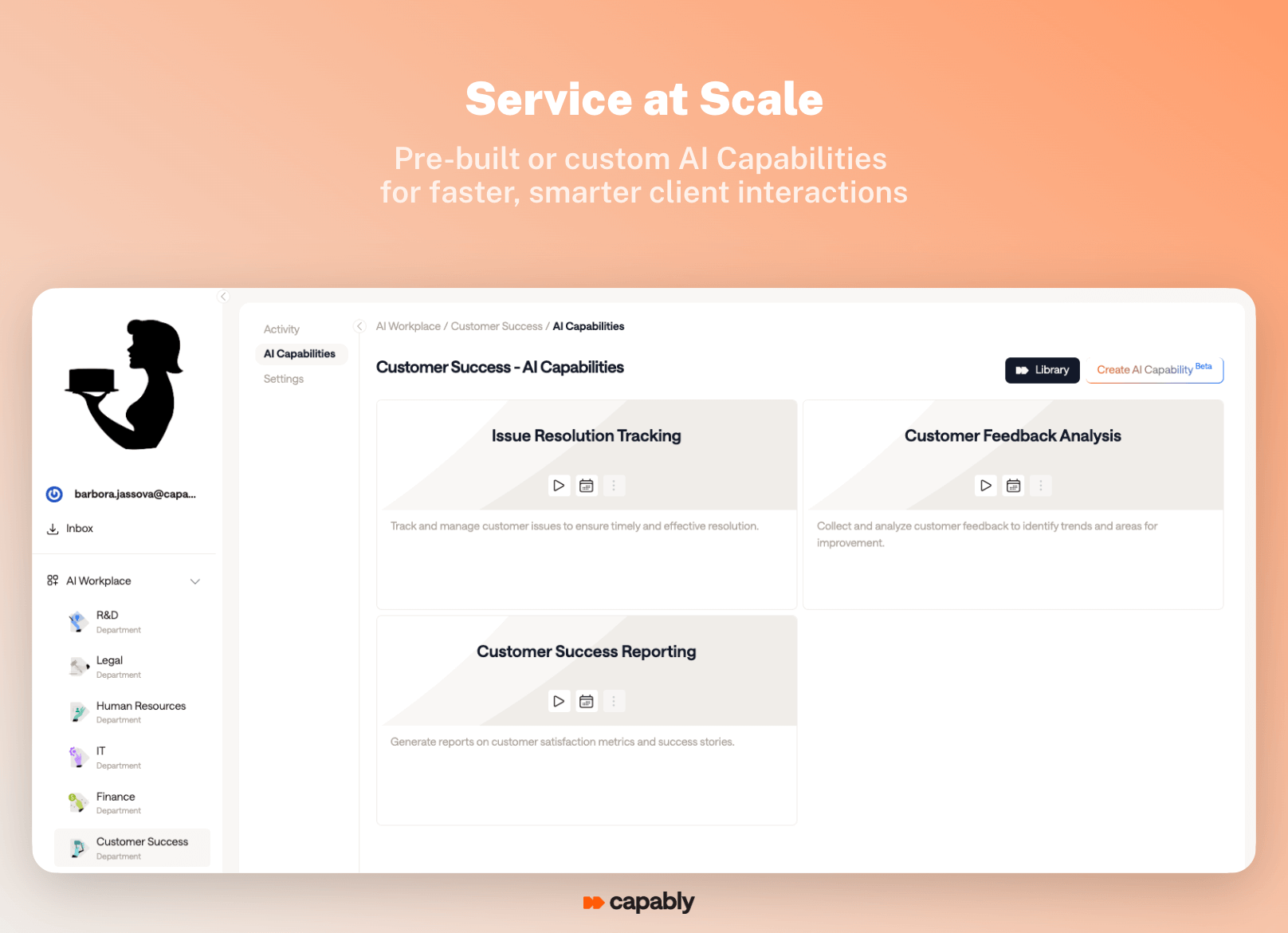
📦 Order Status Updates & Returns Handling
This workflow keeps customers informed automatically. From “order confirmed” to “out for delivery” and even “refund processed.” Reducing communication lag helps manage consumer expectations, reduce support tickets, and make returns smoother.
🧠 Customer Intelligent Insights
Your service data is a goldmine. This automation can analyse support interactions, reviews, and consumer feedback to uncover patterns, such as recurring complaints or feature requests. It gives you actionable data-driven insight into what customers really want (and where they’re getting stuck).
You can also automate triage of support tickets, handle common FAQ queries without human intervention, and ensure internal systems are updated in real time. This way, your support team has the full picture before a customer even picks up the phone. It’s a recipe for building unwavering customer loyalty.
HR & Talent: Smarter Hiring, Happier Teams
FMCG businesses may be product-driven, but people still power everything. From field sales to logistics to R&D, finding, keeping, and developing the right talent is essential. Especially when margins are tight and turnover is high. Automation technology can ease the load on HR teams and sharpen decision-making, without turning people into just data points.
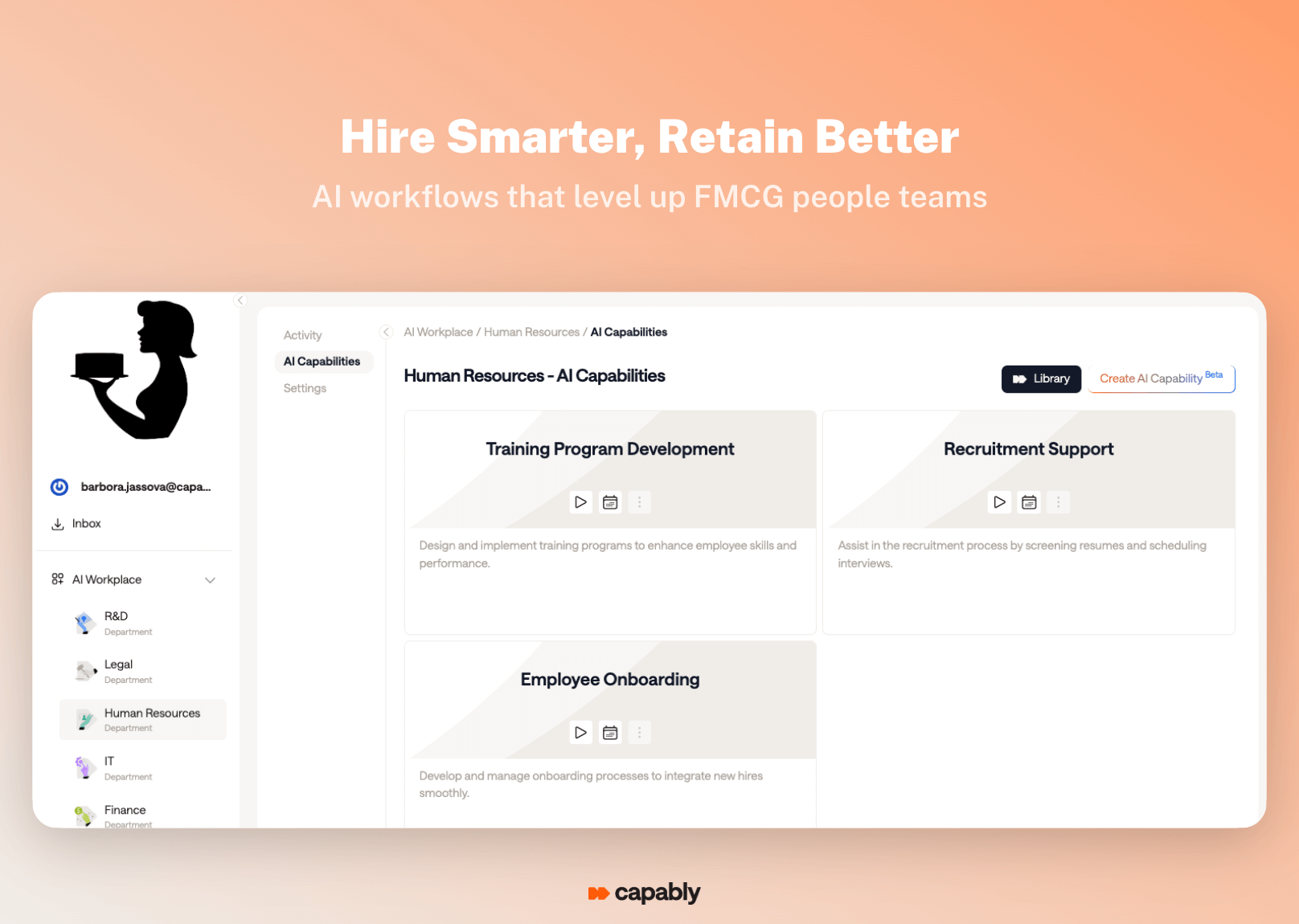
📋 Resume Screening & Talent Acquisition
This workflow helps you quickly and fairly sort through stacks of CVs. Using natural language processing (NLP), it can identify role-fit, flag skills gaps, and surface top candidates faster, cutting time-to-hire while reducing unconscious bias.
📈 Sentiment Analysis & Retention Prediction
Rather than waiting for exit interviews to learn what went wrong, this workflow can help spot patterns in employee feedback, survey responses, or communication trends that signal disengagement. The goal? Keep hold of your top performers before they start updating their LinkedIn.
Other high-impact automations in this area include onboarding new hires with less paperwork, analyzing team skill gaps for training priorities, and streamlining repetitive HR admin. In other words, your people team can focus on culture rather than compliance.
Whether you’re trying to reduce waste, forecast more effectively, personalize campaigns, or retain top talent, technology is catching up. With digital platforms like Capably, intelligent automation becomes achievable and scalable across your business.
In the next section, we’ll look at the flip side: the everyday challenges of AI automation in FMCG, and how to stay ahead of them.
Challenges of Adopting AI (And How to Overcome Them)
Let’s be honest: adopting AI in the FMCG space isn’t without its bumps. Yes, the tech is more innovative than ever. However, the reality on the ground (say, legacy systems, tight teams, shifting compliance rules) can make rollout tricky.
The good news?
Most AI automation challenges can be anticipated and solved with the right approach.
Here’s what to know so you don’t get stuck.
🔐 Data Privacy and Compliance
Between GDPR, POPIA, and retailer-specific requirements, FMCG businesses walk a tightrope when handling customer data. Ensuring regulatory compliance is critical, and automation tools need to play by the rules, with clear data governance policies to match.
Tip: Choose automation platforms that offer built-in privacy controls and audit trails. And involve your legal or compliance team early, not just when things go live.
🔗 Legacy System Integration
If your tech stack is more Frankenstein than finely-tuned engine, you’re not alone. Many FMCG companies rely on a patchwork of old and new systems that don’t always communicate well with each other.
Tip: Look for no-code tools that support API integrations or out-of-the-box data syncs. Starting small, with one workflow that connects systems, can create quick wins and momentum.
⚖️ Bias in Consumer Data
AI only knows what you feed it. If your historical data reflects skewed assumptions (say, past under-investment in specific regions or demographics), those biases can be baked into automation.
Tip: Regularly review your data inputs. Where possible, pair AI outputs with human oversight. Especially for consumer-facing content, hiring, and campaign targeting.
💸 Cost and Change Management
AI doesn’t have to break the bank, but it does require investment in tools, training, and time. Also, people may resist change, especially if they don’t understand what automation will actually do for them
Tip: Start with clear use cases that solve everyday problems (like automating demand forecasts or speeding up order updates). When people see value, they engage.
🧭 Ethical AI Use
AI decisions can impact pricing, hiring, messaging, and even who gets served an ad. As FMCG businesses gain more automation power, the responsibility to use it well grows too.
Tip: Set clear internal principles for AI use. Transparency, fairness, and human-in-the-loop reviews aren’t just nice-to-haves; they build long-term trust.
How to Get Started Without Getting Overwhelmed
Here’s the thing: you don’t need a battalion of data scientists or a year-long roadmap to start automating. In fact, the best place to begin with AI-based automation is often with the repetitive, manual tasks that frustrate your team the most.
Think weekly reports, inventory syncing, or support ticket triage: small wins, big impact.
Start with what’s already slowing you down.
What’s eating hours each week? Where do errors keep cropping up? These pain points often point directly to strong automation candidates. You don’t need to tackle everything at once, just enough to build momentum.
You also don’t need to build from scratch.
Capably offers a library of ready-made, no-code workflows explicitly designed for FMCG use cases so that you can get results without a tech team or endless customization. Want more control? Use the Describe–Critizise–Automate system to create your own workflows in plain English.
Need a step-by-step guide?
We’ve got that too. If you’re ready to dive deeper, check out our Smart Automation Implementation Guide. It’s a practical walkthrough, not a tech manual.
Automation doesn’t need to feel like a moon landing. Start with something simple, see the results, and scale from there. You’ll avoid complexity later by acting earlier.
Final Thoughts: AI in FMCG Automation Is No Longer a Luxury
AI in FMCG automation isn’t about chasing trends; it's about driving digital transformation, meeting rising consumer demands, adapting to external factors like market shifts and supply chain disruptions, and making data-driven decisions that support real business growth.
With AI-powered tools, FMCG businesses, big or small, can turn vast amounts of operational data into profound insights that improve everything from production schedules to quality control. Whether it’s anticipating demand with greater accuracy, fine-tuning personalized marketing messages for stronger customer engagement, or reducing logistics costs through more thoughtful planning, the benefits of automation are concrete and increasingly necessary.
The good news? You don’t have to do it alone, or go big from day one. With platforms like Capably, you can begin with no-code workflows that generate real-time insights and deliver measurable cost savings. It’s a smarter, more flexible way to align your operations with your business goals—without losing sight of what makes your brand competitive in the first place.
A bit of "AI revolution" won’t replace your team. But it will give them the clarity, time, and tools to make faster and better decisions. And in a landscape defined by volatility and competition, that’s more than helpful; it’s essential.
Ready to see what intelligent automation could do for your FMCG business? Your next workflow might be just a few clicks away.
FAQs
What should FMCG leaders look for in an automation partner?
Speed, flexibility, and domain knowledge matter most. You want fast rollout with minimal IT lift, the ability to customize without developer bottlenecks, and workflows tailored to FMCG quirks like promo volatility, supplier variability, and seasonal demand spikes. Capably is purpose-built for these exact needs.
What automation metrics should FMCG teams track quarterly?
Look beyond one-time time savings. Key metrics include: forecast error reduction, working capital tied in inventory, time to resolve service tickets, headcount-to-ticket ratios, and automation adoption rate by function. These indicators reveal both direct savings and cultural integration of automation.
How do we secure stakeholder buy-in for FMCG automation initiatives?
Start with line-of-business champions, not just IT. Show early wins—like faster order turnaround or fewer stockouts—then build momentum. Create visibility through dashboards or alerts, and involve teams in shaping automations. With Capably, business users can test and iterate without needing engineering signoff.
What are the common mistakes companies make when adopting automation?
Three stand out:
- Automating before standardizing processes
- Underestimating the need for clean, structured data
- Relying too heavily on developers for maintenance
A no-code, feedback-loop model like Capably helps avoid all three by making automation business-led and adaptable from day one.
How does Capably compare to traditional RPA or scripting solutions?
Traditional RPA is rigid and focused on mimicking human clicks. Scripting requires developer time and creates maintenance overhead. Capably differs by letting you describe outcomes in plain language, using built-in critique to refine logic, and deploying automation that adapts, without the code sprawl or risk.